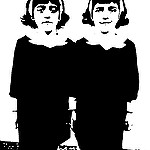Outsiders: American Photography and Film, 1950s-1980s at the Art Gallery of Ontario includes work by photographers Diane Arbus, Nan Goldin, Danny Lyon, Gordon Parks, Garry Winogrand, and cross-dressing individuals at Casa Susanna, and filmmakers Kenneth Anger, Shirley Clarke, Robert Frank and Alfred Leslie, and Marie Menken. This exhibit runs from March 12 to May 29, 2016 and was curated by Jim Shedden and Sophie Hackett.
The Outsiders exhibit portrays a world very different from the glossy photos and films of the era. While ordinary cameras captured clean, beautiful, often famous white heterosexual middle-and upper-class people doing conventional tasks, the “Outsiders” focus their lenses on people at the margins of WASP society: side-show performers, people with tattoos or dirty feet, battered women, nudist colonies, unattractive people, motorcycle gangs, journalists, anti-war rallies, ordinary people at gala parties, homosexuals, men who cross-dress as women, African-Americans, poor families, street people, traumatized children, individuals with physical or mental differences, etc. The resulting works of art shake up a spectator because they challenge conventional notions of normality and the status quo.
With intentional irony, the background music for Outsiders consists of popular songs from the 1960s that emphasize traditional gender roles, such as “I will follow him, follow him wherever he may go . . . ” from Little Peggy March’s song (“I Will Follow Him” was first recorded in 1961 by Franck Pourcel as an instrumental titled Chariot. The song achieved its widest success when it was covered by Little Peggy March in 1963. The music was written by Franck Pourcel and Paul Mauriat, later adapted by Arthur Altman. The English lyrics were written by Norman Gimbel.) Photographers like Nan Goldin, who has a self-portrait of her bruised face after her male lover attacked her, insist that such stereotypical roles often do not work in the real world.
Some of the artists, including Parks and Winogrand, avoid “staging” their subjects, while others like Arbus want their subjects to know that they are performing for a camera. Arbus often focuses on individuals who perform for a living: dancers, sword-swallowers, etc. Unusual situations also captivate her, such as identical twins, triplets, two young women dressed in bikinis with the same design, etc.
Along with the exhibit, the AGO has planned a series of films and lectures about Outsider art. My husband and I attended Jeff Rosenheim’s photo-lecture about Diane Arbus’ work. Rosenheim is the Metropolitan Museum’s Curator of Photography and serves as custodian of the Diane Arbus archive. He gave a good overview of her work and previewed some newly discovered photos that will premiere in July 2016 at the former Whitney Museum in New York. Rosenheim is very knowledgeable. However, I would have appreciated more detailed analyses of Arbus’ photographs.
I highly recommend this exhibit to anyone interested in art that exposes the gritty underside of life. The work of Arbus and others often implies that many of us are performers as we live our lives. This makes one question what is real.

Photo by Diane Arbus of identical twins
Photos by ThatMakesThree,